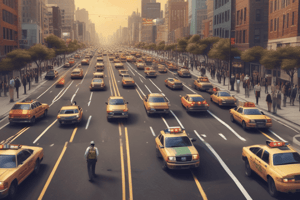Podcast
Questions and Answers
What is the primary purpose of a police vehicle in emergency traffic control?
What is the primary purpose of a police vehicle in emergency traffic control?
- To clear one lane for emergency vehicles
- To block the intersection and detour traffic (correct)
- To provide high visibility to pedestrians
- To assist in turns and protect pedestrians
What is the recommended type of whistle for traffic direction?
What is the recommended type of whistle for traffic direction?
- Electronic
- Plastic (correct)
- Handheld
- Metal
What does one loud long blast of the whistle signify in traffic direction?
What does one loud long blast of the whistle signify in traffic direction?
- Proceed with caution
- Turn left
- Turn right
- Stop (correct)
What is the primary responsibility of traffic direction in an emergency situation?
What is the primary responsibility of traffic direction in an emergency situation?
What is the purpose of an electric signal box in traffic control?
What is the purpose of an electric signal box in traffic control?
What is the recommended type of clothing for traffic control?
What is the recommended type of clothing for traffic control?
Flashcards are hidden until you start studying
Study Notes
Effective Traffic Control
- Wear high-visibility clothing, proper lighting (orange wand), and general clothing suitable for different weather conditions (rain, cold, hot)
- Position yourself in the roadway to evaluate the intersection, command a full view of the intersection, and consider having more than one officer if necessary
Signals and Gestures
- Use the front and back of your body to signal STOP
- Make clear movements with your arms, ensuring motorists can see and understand
- Establish command presence and maintain eye contact
- Use the "arm out, palm out" signal to indicate STOP
Whistle
- Carry a whistle at all times, and prefer a plastic one
- Attach the whistle to your coat or shirt with a chain
- Use one loud, long blast to signal STOP, and two loud, short blasts to signal GO (time to move)
Responsibilities of Traffic Direction
- Eliminate blocked intersections
- Assist turns
- Protect pedestrians
- Clear one lane for emergency vehicles
Electric Signal Box
- Identify the yellow box on the corner
- Test the hand direction before use
- Understand the switches, including on/off reset circuit breakers
- Know how to operate flashers and switch to manual mode using the hand button
Emergency Traffic Control
- Use police vehicles and equipment to block intersections and detour traffic
- Channel traffic from greater lanes to lesser lanes
- Control freeway traffic with high-visibility equipment and multiple officers
Warning Devices
- Use railroad-type fuses (flares) with caution, as they are most dangerous when igniting
- Ensure flares are visible from a distance and do not need to be upright
- Avoid stepping on flares to put them out, and instead, pick them up and rub them out in the earth when finished
Placing Warning Devices
- Start from behind the scene and work towards traffic
- Never turn your back on traffic
- Place flares 20-25 feet apart near the scene, gradually increasing the distance farther from the scene
- Consider the speed of traffic when determining the number of flares to use (e.g., 60mph equals 90 ft.per second)
- Place flares on curves to warn traffic approaching
- Place flares on hills before the crest
Studying That Suits You
Use AI to generate personalized quizzes and flashcards to suit your learning preferences.




